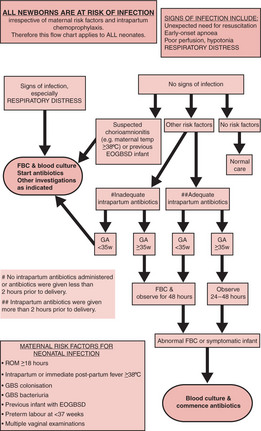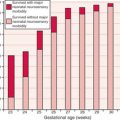CHAPTER 17 Infection risk
Infection risk and signs
Risks of infection increase with:
Signs of infection before delivery may include:
Antibiotic use
There is no magic formula that tells us which babies must be treated with antibiotics.
Antibiotics should be given within half an hour of a decision to start them.
Always take a blood culture before commencing antibiotics.
Arrange a full blood count (FBC) and film examination for the next convenient blood collection time.
For early septicaemia
The most common organisms to cover are group B β-haemolytic Streptococcus (GBS), Escherichia coli and other coliforms.
For suspected late-onset or nosocomial infection (appearing >48 hours after nursery admission)
The basic principle is to cover:
This cover will usually include cover for Gram-positive (with e.g. ampicillin, flucloxacillin or a 1st-generation cephalosporin) and Gram-negative (with e.g. gentamicin or a 3rd-generation cephalosporin) organisms. The antibiotics often have a synergistic effect with each other.
Prevention of neonatal early-onset GBS disease (EOGBSD)
The prevention of early-onset GBS disease requires strategies for both the mother and the baby.
There are two obstetric approaches:
The neonatal approach is outlined below.
Queensland approach
Following consideration of all available information and in the light of the current low rate (0.39/1000 births) of EOGBSD in Queensland in 2002, the Perinatal Clinical Practice Guidelines Working Party on Early Onset Group B Streptococcal Disease and Prelabour Rupture of the Membranes at Term (coordinated by the Centre for Clinical Studies, Mater Hospital, South Brisbane and the Southern Zone Maternal Neonatal and Gynaecology Network, Southern Zone Management Unit) reached a consensus to continue to recommend the modified risk factor approach.
Our suggested approach in light of these guidelines is:





